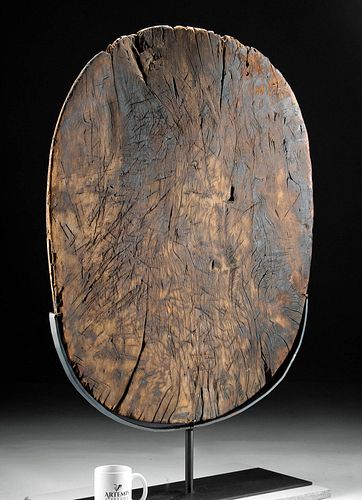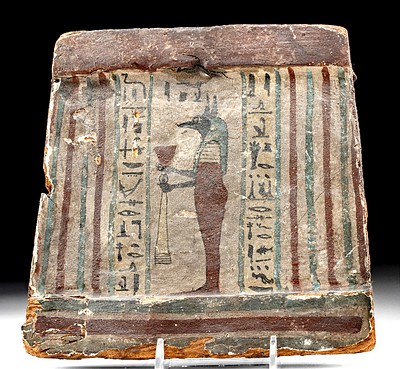Huge 18th C. Hawaiian Koa Wood Pig Platter
Lot 134
About Seller
Artemis Fine Arts
686 S Taylor Ave, Ste 106
Louisville, CO 80027
United States
Selling antiquities, ancient and ethnographic art online since 1993, Artemis Gallery specializes in Classical Antiquities (Egyptian, Greek, Roman, Near Eastern), Asian, Pre-Columbian, African / Tribal / Oceanographic art. Our extensive inventory includes pottery, stone, metal, wood, glass and textil...Read more
Estimate:
$13,000 - $20,000
Absentee vs Live bid
Two ways to bid:
- Leave a max absentee bid and the platform will bid on your behalf up to your maximum bid during the live auction.
- Bid live during the auction and your bids will be submitted real-time to the auctioneer.
Bid Increments
| Price | Bid Increment |
|---|---|
| $0 | $25 |
| $300 | $50 |
| $1,000 | $100 |
| $2,000 | $250 |
| $5,000 | $500 |
| $10,000 | $1,000 |
| $20,000 | $2,500 |
| $50,000 | $5,000 |
| $100,000 | $10,000 |
| $200,000 | $20,000 |
About Auction
By Artemis Fine Arts
Aug 26, 2021
Set Reminder
2021-08-26 10:00:00
2021-08-26 10:00:00
America/New_York
Bidsquare
Bidsquare : Fine Antiquities | Asian | Ethnographic Art
https://www.bidsquare.com/auctions/artemis-gallery/fine-antiquities-asian-ethnographic-art-7366
Features classical antiquities, ancient and ethnographic art from cultures encompassing the globe. Egyptian, Greek, Roman, Etruscan, Near Eastern, Asian, Pre-Columbian, Native American, African / Tribal, Oceanic, Spanish Colonial, Russian, Fine / Visual Arts, so much more! Artemis Fine Arts info@artemisgallery.com
Features classical antiquities, ancient and ethnographic art from cultures encompassing the globe. Egyptian, Greek, Roman, Etruscan, Near Eastern, Asian, Pre-Columbian, Native American, African / Tribal, Oceanic, Spanish Colonial, Russian, Fine / Visual Arts, so much more! Artemis Fine Arts info@artemisgallery.com
- Lot Description
North Pacific, Hawaii, ca. 18th to 19th century CE. An impressive and quite sizable platter finely carved from koa wood and intended to hold a kalua pig - a pig that has been roasted in an underground oven. This huge dish is formed from a single slab of wood that, although is for the most part flat, displays a slightly convex bottom, gently upward-curved peripheries, and a very shallow basin. Deep natural grooves add a lovely texture to the piece's surface, as the gorgeous woodgrain boasts rich hues of caramel, chocolate, and mocha. Size: 36.75" L x 29" W (93.3 cm x 73.7 cm); 43.5" H (110.5 cm) on included custom stand.
Hawaiian wood dishes, such as this example, were used for serving and storing poi, salting and serving meat, and storing tapa cloth and feathers. It is possible that this dish would have been used at a luau feast, which takes its name from the Hawaiian word for the taro leaf that resembles roasted spinach once steamed for a few hours. The Hawaiian luau began in 1819 when King Kamehameha II removed the religious kapu (taboo) system that restricted women and commoners from eating delicacies and women from eating with men. To introduce the people to this new system, the king performed a symbolic act by inviting women to dine with him, thereby hosting the first luau. The luau feast is traditionally eaten by hand and served on floor mats decorated with large centerpieces made of ti leaves.
According to the Hearst Museum of Anthropology at University of California, Berkeley, "Carvers preferred the wood of the koa (or kou) tree because its grain was relatively soft and easy to cut. Food bowls were carefully carved from hardwoods with stone and later metal tools; some were also hollowed out with fire. Next, the bitterness in the wood was removed by soaking in sea water; the wood was further sweetened by an application of fermented taro or sweet potato. Finally, the bowl was polished with pumice or shark skin, and rubbed to a high gloss with nut oil. This coating helped waterproof the wood, extending its life."
This piece has been searched against the Art Loss Register database and has been cleared. The Art Loss Register maintains the world’s largest database of stolen art, collectibles, and antiques.
Provenance: private Hawaii, USA collection; ex-B. Mackley collection, Pennsylvania, USA, acquired in 2005
All items legal to buy/sell under U.S. Statute covering cultural patrimony Code 2600, CHAPTER 14, and are guaranteed to be as described or your money back.
A Certificate of Authenticity will accompany all winning bids.
PLEASE NOTE: Due to recent increases of shipments being seized by Australian & German customs (even for items with pre-UNESCO provenance), we will no longer ship most antiquities and ancient Chinese art to Australia & Germany. For categories of items that are acceptable to ship to Australia or Germany, please contact us directly or work with your local customs brokerage firm.
Display stands not described as included/custom in the item description are for photography purposes only and will not be included with the item upon shipping.
#165838Collection label near bottom. Several stable pressure fissures throughout. Expected nicks, abrasions, and surface losses, commensurate with age and use. Otherwise, remarkable for its age with beautiful patina.Condition
- Shipping Info
-
All shipping is handled in-house for your convenience. Your invoice from Artemis Gallery will include shipping calculation instructions. If in doubt, please inquire BEFORE bidding for estimated shipping costs for individual items.
-
- Buyer's Premium



 EUR
EUR CAD
CAD AUD
AUD GBP
GBP MXN
MXN HKD
HKD CNY
CNY MYR
MYR SEK
SEK SGD
SGD CHF
CHF THB
THB













